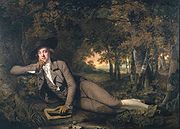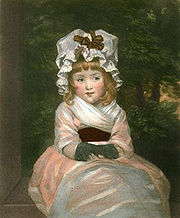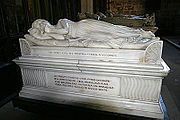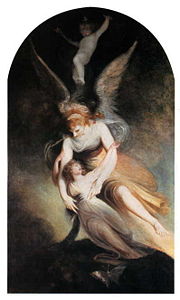
Sir Brooke Boothby, 6th Baronet
Encyclopedia
Sir Brooke Boothby, 6th Baronet was an English linguist, translator, minor poet and landowner in Derbyshire
. He was part of the intellectual and literary circle of Lichfield which included Anna Seward
and Erasmus Darwin
. He welcomed Jean-Jacques Rousseau
to Ashbourne circles in 1766 when the philosopher fled London after a short stay there where hospitality was provided by Hume. Boothby visited Rousseau in Paris in 1776 and was given the manuscript of the first part of Rousseau's three part Confessions which was his autobiography. Boothby translated the manuscript and published in Lichfield in 1780 after the author's death and donated the document to the British Library in 1781. Boothby's unusual portrait by Joseph Wright of Derby
from 1781, a classic example of English 18th century painting, shows him reclining in a wooded glade with a book carrying on its cover simply the name Rousseau, indicating his interest in the writer and his work generally rather than one of Rousseau's works in particular. The portrait is a metaphor for Boothby's admiration of Rousseau and his efforts to promote him with the English intelligentsia. His daughter was painted by Henry Fuseli
and Joshua Reynolds
and sculpted by Thomas Banks
, as well as being the subject of a book of poetry by her grieving father.
, William Boothby. Brooke Boothby is sometimes referred to as the seventh baronet as there was some confusion over the appointment of the first baronet.

 Boothby was active in local intellectual life as an associate of the scientific group, the Lunar Society
Boothby was active in local intellectual life as an associate of the scientific group, the Lunar Society
which was interested in the application of the sciences to modern life and its development, and the Lichfield Botanical Society. He, members of the Lunar Society and the intellectual circle of Lichfield, met the free-thinking Jean-Jacques Rousseau
who fled from France in 1766-7 and was staying at Wootton
, near Boothby's home, Ashbourne Hall.
Boothby later visited Rousseau in Paris and promised him that he would publish his Confessions, an autobiographical work to which Boothby gave the title "Dialogues ou Rousseau, Juge de Jean-Jacques". The book was published in Lichfield by Boothby in the French language. This achievement is immortalised in Joseph Wright of Derby
's painting. The portrait shows Boothby reclining by a stream in a wooded glade once known as the Twenty Oaks where he and Rousseau met for discussion and where Rousseau went to write in peace and solitude. He is holding a leather bound book with the name Rousseau on the spine rather than a specific title, thus referencing Boothby's interest in the philosopher's entire oeuvre. The landscape setting can be interpreted as referring to the Rousseauian idea that all of man's troubles and unhappiness derive from his self-removal from the natural world. The plants in the setting refer to Boothby's interest in botany and the botanical aspect of the painting has withstood academic interest. Both Boothby and Rousseau were interested in botany and Rousseau studied local flora when he lived at Wootton Hall.
Two other of Wright's paintings of Dovedale
were sold to Brooke Boothby who had helped Wright when he put on the first one-man exhibition in London. Boothby also purchased two views of nearby Matlock, two paintings of bridges in Rome as well as the unusual portrait of himself.
Boothby married Susanna Bristoe, daughter of Robert Bristoe and Susanna Philipson, in 1784 and in that year he leased Ashbourne Hall
from his father whose extravagance had forced him to live elsewhere whilst renting out the family seat. He began the restoration of Ashbourne Hall using his wife's dowry to renovate the structure, remodel the parkland, purchase rare plants and obtain works of art. Boothby, like his father before him, was extravagant in the extreme. That weakness and his emotion self-indulgence were to be his nemesis. In the following April, his only daughter, Penelope, was born. Sir Joshua Reynold's portrait of Penelope, often called "the Mob Cap" is one of the most famous of English child portraits. Reynolds had painted portraits of Boothby and his younger half sister Anne. His full sister, Maria, was portrayed by Wright a decade before he painted the famous portrait of Brooke Boothby himself.

 On 19 March 1791, disaster struck when Boothby's young daughter, Penelope, died aged five. This sad event permanently affected Boothby and he published a book of poetry, Sorrows Sacred to the Memory of Penelope subsequent to the event. Penelope had a remarkable tomb constructed for her which included a life size statue of her sleeping. The tomb is in Saint Oswald's church in Ashbourne along with many other Boothby memorials and graves.
On 19 March 1791, disaster struck when Boothby's young daughter, Penelope, died aged five. This sad event permanently affected Boothby and he published a book of poetry, Sorrows Sacred to the Memory of Penelope subsequent to the event. Penelope had a remarkable tomb constructed for her which included a life size statue of her sleeping. The tomb is in Saint Oswald's church in Ashbourne along with many other Boothby memorials and graves.
Boothby's life went into decline after his daughter's death. He commissioned the sculpture illustrated and the painting by Henry Fuseli
. His wife Susanna returned after Penelope's funeral to her parent's home in Hampshire and settled in Dover. Her death was recorded under her own family name, Bristoe.
Boothby was involved with the substantial purchase of sixteenth century stained glass for Lichfield Cathedral
in 1801, which he purchased from the Abbey of Herkenrode which had been dissolved in the Napoleonic wars. He sold the glass to the cathedral on a non-profit basis.
As a result of his extravagance Boothby met with economic disaster which completely altered the course of his life. Ashbourne Hall was leased in 1814 (parish records show that in 1817 Sir Richard Arkwright's grandson, also Richard, was living there) and he settled in diminished circumstances in Boulogne
in 1815 and died there in 1824. He was buried in St. Oswald's with his parents and his sister Maria Elizabeth and other Boothby family members.
Well has thy classick chisel, Banks
, express'd
The graceful lineaments of that fine form,
Which late with conscious, living beauty warm,
Now here beneath does in dread silence rest.
And, oh, while life shall agitate my breast,
Recorded there exists her every charm,
In vivid colours, safe from change or harm,
Till my last sigh unalter'd love attest.
That form, as fair as ever fancy drew,
The marble cold, inanimate, retains;
But of the radiant smile that round her threw
Joys, that beguiled my soul of mortal pains,
And each divine expression's varying hue,
A little senseless dust alone remains
Derbyshire
Derbyshire is a county in the East Midlands of England. A substantial portion of the Peak District National Park lies within Derbyshire. The northern part of Derbyshire overlaps with the Pennines, a famous chain of hills and mountains. The county contains within its boundary of approx...
. He was part of the intellectual and literary circle of Lichfield which included Anna Seward
Anna Seward
Anna Seward was an English Romantic poet, often called the Swan of Lichfield.-Life:Seward was the elder daughter of Thomas Seward , prebendary of Lichfield and Salisbury, and author...
and Erasmus Darwin
Erasmus Darwin
Erasmus Darwin was an English physician who turned down George III's invitation to be a physician to the King. One of the key thinkers of the Midlands Enlightenment, he was also a natural philosopher, physiologist, slave trade abolitionist,inventor and poet...
. He welcomed Jean-Jacques Rousseau
Jean-Jacques Rousseau
Jean-Jacques Rousseau was a Genevan philosopher, writer, and composer of 18th-century Romanticism. His political philosophy influenced the French Revolution as well as the overall development of modern political, sociological and educational thought.His novel Émile: or, On Education is a treatise...
to Ashbourne circles in 1766 when the philosopher fled London after a short stay there where hospitality was provided by Hume. Boothby visited Rousseau in Paris in 1776 and was given the manuscript of the first part of Rousseau's three part Confessions which was his autobiography. Boothby translated the manuscript and published in Lichfield in 1780 after the author's death and donated the document to the British Library in 1781. Boothby's unusual portrait by Joseph Wright of Derby
Joseph Wright of Derby
Joseph Wright , styled Wright of Derby, was an English landscape and portrait painter. He has been acclaimed as "the first professional painter to express the spirit of the Industrial Revolution"....
from 1781, a classic example of English 18th century painting, shows him reclining in a wooded glade with a book carrying on its cover simply the name Rousseau, indicating his interest in the writer and his work generally rather than one of Rousseau's works in particular. The portrait is a metaphor for Boothby's admiration of Rousseau and his efforts to promote him with the English intelligentsia. His daughter was painted by Henry Fuseli
Henry Fuseli
Henry Fuseli was a British painter, draughtsman, and writer on art, of Swiss origin.-Biography:...
and Joshua Reynolds
Joshua Reynolds
Sir Joshua Reynolds RA FRS FRSA was an influential 18th-century English painter, specialising in portraits and promoting the "Grand Style" in painting which depended on idealization of the imperfect. He was one of the founders and first President of the Royal Academy...
and sculpted by Thomas Banks
Thomas Banks
Thomas Banks , English sculptor, son of a surveyor who was land steward to the Duke of Beaufort, was born in London. He was taught drawing by his father, and in 1750 was apprenticed to a woodcarver. In his spare time he worked at sculpture, spending his evenings in the studio of the Flemish émigré...
, as well as being the subject of a book of poetry by her grieving father.
Biography
Boothby was born in 1744. He inherited his unusual forename from Hill Brooke, the second wife of the fourth Boothby Baronet of Broadlow AshBoothby Baronets
There have been two Baronetcies created for persons with the surname Boothby, both in the Baronetage of England. One creation is extant as of 2008....
, William Boothby. Brooke Boothby is sometimes referred to as the seventh baronet as there was some confusion over the appointment of the first baronet.


Lunar Society
The Lunar Society of Birmingham was a dinner club and informal learned society of prominent figures in the Midlands Enlightenment, including industrialists, natural philosophers and intellectuals, who met regularly between 1765 and 1813 in Birmingham, England. At first called the Lunar Circle,...
which was interested in the application of the sciences to modern life and its development, and the Lichfield Botanical Society. He, members of the Lunar Society and the intellectual circle of Lichfield, met the free-thinking Jean-Jacques Rousseau
Jean-Jacques Rousseau
Jean-Jacques Rousseau was a Genevan philosopher, writer, and composer of 18th-century Romanticism. His political philosophy influenced the French Revolution as well as the overall development of modern political, sociological and educational thought.His novel Émile: or, On Education is a treatise...
who fled from France in 1766-7 and was staying at Wootton
Wootton
Wootton is an English place name meaning place by the wood. The standard pronunciation rhymes the first syllable with foot.-Places:Places in England called Wootton:*Wootton, Bedfordshire*Wootton, Dorset*Wootton, Hampshire, village near Basingstoke...
, near Boothby's home, Ashbourne Hall.
Boothby later visited Rousseau in Paris and promised him that he would publish his Confessions, an autobiographical work to which Boothby gave the title "Dialogues ou Rousseau, Juge de Jean-Jacques". The book was published in Lichfield by Boothby in the French language. This achievement is immortalised in Joseph Wright of Derby
Joseph Wright of Derby
Joseph Wright , styled Wright of Derby, was an English landscape and portrait painter. He has been acclaimed as "the first professional painter to express the spirit of the Industrial Revolution"....
's painting. The portrait shows Boothby reclining by a stream in a wooded glade once known as the Twenty Oaks where he and Rousseau met for discussion and where Rousseau went to write in peace and solitude. He is holding a leather bound book with the name Rousseau on the spine rather than a specific title, thus referencing Boothby's interest in the philosopher's entire oeuvre. The landscape setting can be interpreted as referring to the Rousseauian idea that all of man's troubles and unhappiness derive from his self-removal from the natural world. The plants in the setting refer to Boothby's interest in botany and the botanical aspect of the painting has withstood academic interest. Both Boothby and Rousseau were interested in botany and Rousseau studied local flora when he lived at Wootton Hall.
Two other of Wright's paintings of Dovedale
Dovedale by Moonlight
Dovedale by Moonlight is one of five paintings by Joseph Wright of Derby which uses the picturesque valley of Dovedale as its subject. These paintings were sometimes made as pairs with one showing the view by day and the other by moonlight...
were sold to Brooke Boothby who had helped Wright when he put on the first one-man exhibition in London. Boothby also purchased two views of nearby Matlock, two paintings of bridges in Rome as well as the unusual portrait of himself.
Boothby married Susanna Bristoe, daughter of Robert Bristoe and Susanna Philipson, in 1784 and in that year he leased Ashbourne Hall
Ashbourne Hall
Ashbourne Hall is a Manor house originally built by the Cockayne Family in the 13th century in Ashbourne, Derbyshire. The present Hall is part of a largely demolished, Georgian styled Hall build during the 18th century.-The Cockayne Family:...
from his father whose extravagance had forced him to live elsewhere whilst renting out the family seat. He began the restoration of Ashbourne Hall using his wife's dowry to renovate the structure, remodel the parkland, purchase rare plants and obtain works of art. Boothby, like his father before him, was extravagant in the extreme. That weakness and his emotion self-indulgence were to be his nemesis. In the following April, his only daughter, Penelope, was born. Sir Joshua Reynold's portrait of Penelope, often called "the Mob Cap" is one of the most famous of English child portraits. Reynolds had painted portraits of Boothby and his younger half sister Anne. His full sister, Maria, was portrayed by Wright a decade before he painted the famous portrait of Brooke Boothby himself.


Boothby's life went into decline after his daughter's death. He commissioned the sculpture illustrated and the painting by Henry Fuseli
Henry Fuseli
Henry Fuseli was a British painter, draughtsman, and writer on art, of Swiss origin.-Biography:...
. His wife Susanna returned after Penelope's funeral to her parent's home in Hampshire and settled in Dover. Her death was recorded under her own family name, Bristoe.
Boothby was involved with the substantial purchase of sixteenth century stained glass for Lichfield Cathedral
Lichfield Cathedral
Lichfield Cathedral is situated in Lichfield, Staffordshire, England. It is the only medieval English cathedral with three spires. The Diocese of Lichfield covers all of Staffordshire, much of Shropshire and part of the Black Country and West Midlands...
in 1801, which he purchased from the Abbey of Herkenrode which had been dissolved in the Napoleonic wars. He sold the glass to the cathedral on a non-profit basis.
As a result of his extravagance Boothby met with economic disaster which completely altered the course of his life. Ashbourne Hall was leased in 1814 (parish records show that in 1817 Sir Richard Arkwright's grandson, also Richard, was living there) and he settled in diminished circumstances in Boulogne
Boulogne-Billancourt
Boulogne-Billancourt is a commune in the western suburbs of Paris, France. It is located from the centre of Paris. Boulogne-Billancourt is a sub-prefecture of the Hauts-de-Seine department and the seat of the Arrondissement of Boulogne-Billancourt....
in 1815 and died there in 1824. He was buried in St. Oswald's with his parents and his sister Maria Elizabeth and other Boothby family members.
"Sonnet XII" by Boothby
Well has thy classick chisel, Banks
Thomas Banks
Thomas Banks , English sculptor, son of a surveyor who was land steward to the Duke of Beaufort, was born in London. He was taught drawing by his father, and in 1750 was apprenticed to a woodcarver. In his spare time he worked at sculpture, spending his evenings in the studio of the Flemish émigré...
, express'd
The graceful lineaments of that fine form,
Which late with conscious, living beauty warm,
Now here beneath does in dread silence rest.
And, oh, while life shall agitate my breast,
Recorded there exists her every charm,
In vivid colours, safe from change or harm,
Till my last sigh unalter'd love attest.
That form, as fair as ever fancy drew,
The marble cold, inanimate, retains;
But of the radiant smile that round her threw
Joys, that beguiled my soul of mortal pains,
And each divine expression's varying hue,
A little senseless dust alone remains
Major works
- Letter to the Right Honourable Edmund BurkeEdmund BurkeEdmund Burke PC was an Irish statesman, author, orator, political theorist and philosopher who, after moving to England, served for many years in the House of Commons of Great Britain as a member of the Whig party....
, 1790 - Observations on the Appeal from the New to the Old Whigs, 1792,
- Sorrows. Sacred to the Memory of Penelope, 1796
- Venality, 1793 and 1802
- Translation of Jean RacineJean RacineJean Racine , baptismal name Jean-Baptiste Racine , was a French dramatist, one of the "Big Three" of 17th-century France , and one of the most important literary figures in the Western tradition...
’s BritannicusBritannicus (play)Britannicus is a tragic play by the French dramatist Jean Racine.The play, produced in 1669, was the first time Racine had tried his hand at depicting Roman history. The tale of moral choice takes as its subject Britannicus, the son of the Roman emperor Claudius, and heir to the imperial throne...
, 1803 - Fables and Satires, 1809, Edinburgh
- Translation of MolièreMolièreJean-Baptiste Poquelin, known by his stage name Molière, was a French playwright and actor who is considered to be one of the greatest masters of comedy in Western literature...
’s Le MisanthropeLe MisanthropeThe Misanthrope is a 17th-century comedy of manners in verse written by Molière. It was first performed on 4 June 1666 at the Théâtre du Palais-Royal, Paris by the King's Players....
, 1819) - The Fudger Fudged, 1819).
See also
- Boothby BaronetsBoothby BaronetsThere have been two Baronetcies created for persons with the surname Boothby, both in the Baronetage of England. One creation is extant as of 2008....
- Henry Fuseli's "The Nightmare" which was bought by Boothby
- Andrew Graciano, “‘The Book of Nature is Open to All Men’: Geology, Mining and History in Joseph Wright’s Derbyshire Landscapes” The Huntington Library Quarterly (68: 4, 2005), 583–600.
- Andrew Graciano, ed., Visualising the Unseen, Imagining the Unknown, Perfecting the Natural: Art and Science in the 18th and 19th Centuries, Cambridge Scholars Publishing, 2008.
External links
- Jacques Zonneveld. Sir Brooke Boothby: Rousseau's Roving Baronet Friend. De Nieuwe Haagsche: Uitgeverij, 2003. Pp. 542.
- Boothby at Sonnets.org accessed 25 May 2008

